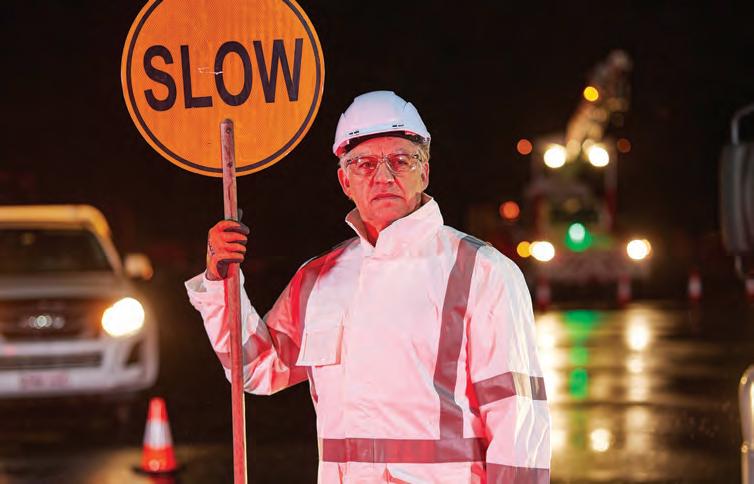
4 minute read
Blackwoods the right choice for PPE
Making the right PPE choice with Blackwoods
BLACKWOODS’ TEAM OF TECHNICAL SOLUTIONS EXPERTS ASSIST THE COMPANY’S INDUSTRY PARTNERS TO BUILD CUSTOMISED SAFETY SOLUTIONS FOR THE MINING AND RESOURCES SECTOR.
Personal protection equipment (PPE) is the frontline defence when it comes to keeping a worker safe from the dangers of chemicals.
With most industries often using a range of chemicals, it is critical that workers are issued with suitable PPE that will provide the highest level of safety within their work environment.
Protection from harmful chemicals and substances requires a complete head-to-toe solution.
Blackwoods is committed to maintaining its place as Australia’s first choice for industrial and safety products and services by continually maintaining and improving the quality of its processes and products.
The company offers a vast range of PPE to ensure that its products and services meet the relevant legislative and industry-based requirements, and comply with recognised local and international standards.
PROTECTIVE EYEWEAR’S IMPORTANCE
The correct eyewear can prevent harmful chemicals from making contact with a worker’s eye. However, the major reason eyewear is removed is due to the glasses fogging or getting scratched.
To help prevent this risk, employers should protect their workers with the appropriate safety eyewear, containing lenses that have been treated with an effective anti-fog or anti-scratch coating.
“Anyone familiar with the European Standards would know of K and N labels and their meaning,” Blackwoods product development manager Nic Williams tells Safe to Work.
“K relates to surface resistance from small particles, while N is resistance to lens fogging in humid environments, including those with persistent condensation. The new PROSAFE KOORBAT and KOWAR styles meet the K and N testing requirements.”
Both PROSAFE styles contain a premium anti-fog and anti-scratch coating in both clear and smoke lenses. This coating is applied in a proprietary dipping process and then heat-treated to permanently bond to the lens.
Using safety glasses with effective coatings helps safeguard workers to enable them to see clearly for long periods, allowing them to stay safe and more productive in most environmental conditions.
THE NEED FOR COVERALLS
Blackwoods technical safety specialist Drew Dauncey says there are various types of coveralls to protect workers from a broad range of chemicals.
“Most workers will never need to look further than a type 5/6 coverall, to protect them from dry chemical powder and liquid droplets,” Dauncey says.
“The best way to ensure the correct coverall is selected is to compare the chemicals being used against a coverall permeation guide.
“No two workplaces are the same
Protective coveralls undergo rigorous testing.

so it’s best to engage with a safety specialist to ensure that the appropriate protective coverall is identified.
“We can do the analysis of the chemicals being used with the coverall permeation data to select the correct coverall.”
Protective coveralls undergo rigorous testing to ensure that they provide the correct level of protection.
Different chemicals will break through the coverall at different times so it’s important to understand the permeation data and how they interact with specific environmental conditions.
“It’s the very reason why many coveralls are disposable and should be replenished frequently,” Dauncey says.
“While there’s a lot of permeation data available, at the base level employers should familiarise themselves with the EN standards and types for guidance.
“When selecting a chemical coverall for your workplace, ensure they have the EN standards marked on the garment. For example, a type 5/6 should display the pictograms for particles and liquid droplets along with EN 13034 and EN 13982.
“Some, but not all coveralls, will have antistatic properties so it’s imperative that you check for the ‘lightning bolt’ pictogram, if you work in a hazardous electrical environment.”
RESPIRATOR FILTERS ENSURE SAFE ENVIRONMENTS
In the workplace, there are many airborne hazards which can enter via the respiratory system and pose a significant risk to worker’s safety and health. Some of these are potentially fatal or can lead to illness and disease.
Coveralls can protect workers from chemical spills. Blackwoods offers a vast range of PPE.

Occupational lung diseases are caused by exposure to hazardous dusts and/or chemicals in the workplace.
Contaminants include silica dust, concrete particulates, various fumes and vapours, pesticides and fuels. Industries where there is a risk include manufacturing, construction, engineering, agriculture, transport and storage.
The initial selection of any respirator and filter needs to be conducted by someone with a full knowledge of respiratory hazards in the workplace. The correct fitting and wearing of a respirator are essential as one size does not fit all.
The team at Blackwoods can help companies find the best fit for the right workplace. This includes particulate filters, gas and vapour filters or combination filters.
Blackwoods’ team of technical experts are also able to build customised solutions for any business in a range of areas.
Over the past 140 years, the company has grown from a small marine supply business to Australia’s largest provider of industrial and safety supplies, with a range of more than 300,000 products from the world’s best brands.










